Everyone probably has a hairdryer in their home. This device makes life much easier for the weaker half of humanity, but few people realize that with the help of an ordinary hair dryer you can do a lot of useful things. Today we will present to you 13 unusual ways use of this household device.
1. Peel off stickers and price tags. You can spend hours using a stationery knife to try to peel off the sticker that your child stuck on in a rush of research. However, with a knife or blade you will definitely scratch the wood or glass. By pointing the hair dryer for a few seconds, you can easily get rid of this misunderstanding. Hot air will instantly melt the glue, which can simply be wiped off with a rag.
2. Are you having trouble adjusting the temples of your plastic glasses to the shape of your head? Do not bend them with your hands; your effort will only break them. Direct a stream of hot air onto the plastic and then bend it easily, like plasticine. However, we do not recommend doing this with expensive designer glasses.
3. Hardened wax on wooden, and especially polished furniture can turn into a housewife's nightmare. Heat the wax on medium heat until it begins to melt, then remove easily with a cloth.
4. Do you want to make your cake or pastry especially attractive? Heat the glaze with hot air from a hairdryer and you are ready to serve!
5. Did you accidentally splash water on your clothes? Remove the wet part of the clothing and hang it on the dryer. Then turn on the hair dryer and dry wet spots in seconds.
6. It’s unpleasant when the mirror in the bathroom sweats from steam. Direct a stream of hot air onto the glass and you can continue drying your hair.
7. The hard drive attracts dust. To avoid buying a special vacuum cleaner, use a regular hair dryer. The air flow will be able to reach the most secluded corners of the house. Use this technique also for woodwork, paintings, bookshelves, lamps, and so on.
8. If you need to apply warm compresses, point the hair dryer at a wet towel. This way you will maintain the desired temperature all the time, which is very convenient.
9. All children love to draw on the walls. If this happens to you, don’t be upset. Pencils are made using wax. Point the hairdryer at the “drawing”, wait a little and wipe it off with a damp cloth.
10. A hairdryer will help you out wonderfully in a snowy winter. To quickly dry your shoes, point the hair dryer at them. And there will be no streams of melting snow in your house.
11. If your windows are frozen because you did not close them tightly or there are cracks. Take a hairdryer and defrost them easily.
12. Girls know how long it takes nail polish to dry. And if you need to act quickly, turn on the warm air and gently dry your nails with a hairdryer.
13. Do you urgently need to defrost a piece of meat or peas? Take a hairdryer and do it in a matter of minutes. This is much safer than microwaving, where the middle usually stays frozen and the edges are already cooked.
It would seem like a simple device: a heating element and a fan. At the same time, with its help you can perform so many operations that you can replace a hair dryer at home with practically nothing. How to choose the right hair dryer
Maybe a blowtorch or a gas torch. But these devices do not have a temperature or blowing speed controller, and an uncontrolled flame can easily cause a fire.
There are a lot of industrial samples: from a simple “wind blower” to devices with intelligent control modes.
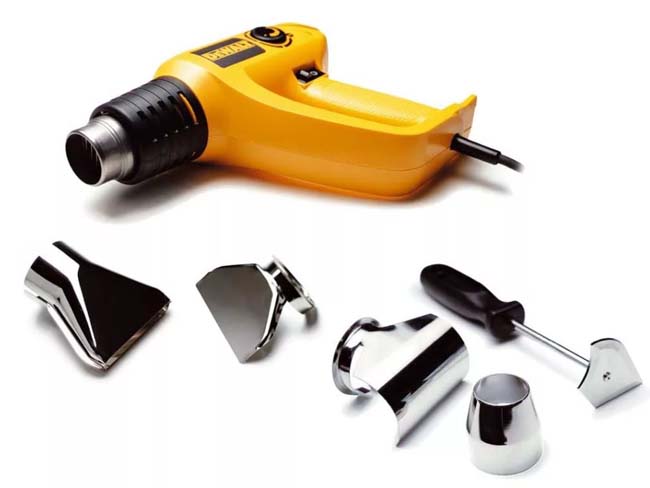
Various nozzles allow you not only to heat the selected area, but also to weld pipes and linoleum.
Areas of application for a construction hair dryer:
- Express drying of wet surfaces.
- Acceleration of hardening of adhesive joints.
- Softening of bitumen bases (car sound insulation, soft roofing, etc.).
- Waxing of various surfaces.
- Surface treatment before painting: removing old coating, degreasing.
- Dismantling of vinyl and plastic coverings (linoleum, plastic tiles).
- Peeling off self-adhesive materials (stickers, window tinting, etc.).
- Softening plastics with a low melting point to give them the required shape.
- Local heating of surfaces, if required by the work technology.
- Melting of fusible metals, tinning, soldering.
- Forming thin wooden products.
- Using polypropylene pipes as a soldering iron.
- Loosening stuck bolted connections.
- "Letting go" of hardened steel.
- Crimping of heat-shrinkable pipes.
- Defrosting pipelines and locks.
- Lighting fireplaces, charcoal grills.
Almost none of these operations can be performed with another device, according to at least, with the same comfort and convenience.
To understand how a hair dryer works, you need to remember the structure of a household fan heater.
The structure of a construction hair dryer is clearly visible in the illustration:
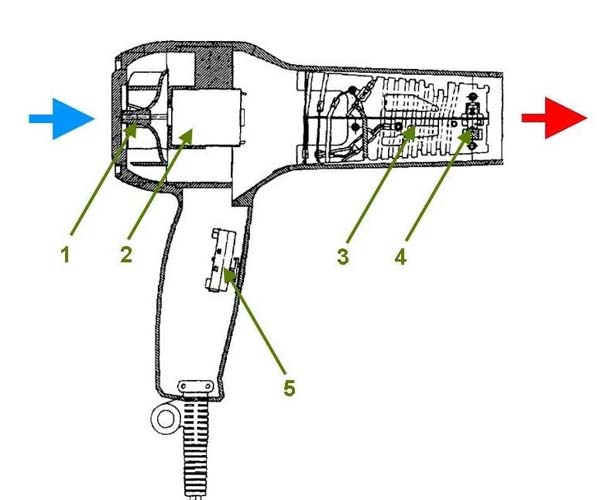
There is a fan in the back (1) on the axis of the electric motor (2) . Further, a powerful heating element is placed in a heat-resistant pipe (3) .
It is made of low resistance nichrome wire. When an electric current flows, the wire becomes hot and the air flow passing through it heats up.
A protection device is installed at the output of the device (4) in the form of a bimetallic switch. When overheating, the contacts open and the hair dryer stops working until it cools down.
There is also a simpler electrical circuit for a hair dryer with protection. The engine is switched on in series with the heating element, and when the windings break (the engine stops), heating also stops.
A control unit is installed in the handle (5) . This could be a switch with several operating modes, or a temperature controller. In the first case, heating is regulated by connecting the heating filament in different combinations.
Less resistance means higher heating temperature and power consumption. In the second case, you can set the temperature with higher accuracy.
Despite the undeniable convenience of the design, it is not always possible to spend money on its purchase. We will tell you how to make a hair dryer with your own hands.
Simple design of a homemade construction hair dryer
We immediately warn against attempts to convert the hair dryer into a more powerful heating element. The housing is designed for a certain temperature, no more than 300 C°.
Construction hair dryer heats the air to at least 650 C°, and more advanced options up to 800 C°. A household appliance will melt within a few minutes of operation, and this is best case scenario. Plastic may ignite in your hands.
Since it is not easy to find heat-resistant plastic, you can make a DIY hair dryer from metal. To do this, it is not necessary to sharpen lathe steel blank, you can mold the body from tin.
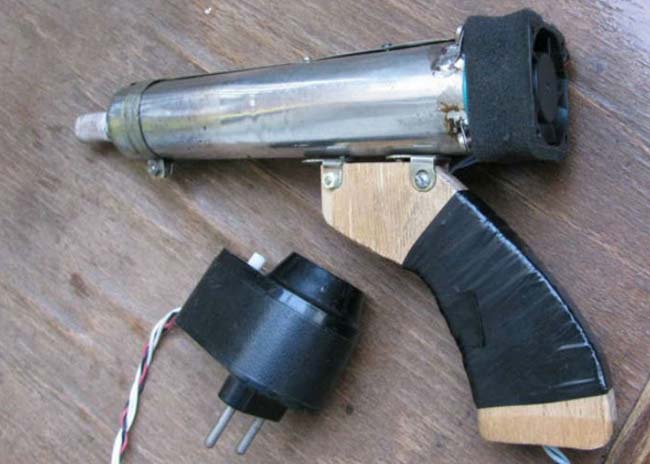
Another housing option is made of heat-resistant glass. You can carefully cut the bulb from a powerful halogen lamp. To do this, the glass is wrapped with a thread dipped in kerosene, the thread is set on fire, and lowered into a container of water. IN in the right place a neat crack appears.
The next element is the heater
Its manufacture must be carefully considered, since it is a matter of safe operation. The insulator core can be ceramic, but this is ineffective since free passage of air is not ensured.
It is necessary to obtain mica plates (in this case, a ready-made structure from a burnt household hair dryer will do). You can purchase a ready-made element in spare parts stores for household power tools.
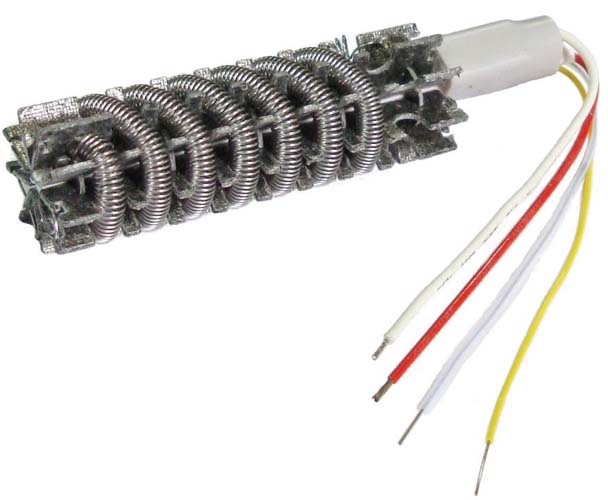
If you wind the spiral yourself, you need to correctly calculate the parameters. It is more convenient to make a two-mode hair dryer, with separate spirals for each temperature.
Normal resistance:
- 1 spiral about 80-100 Ohm
- 2 spiral about 200-250 Ohm
Having selected a suitable nichrome wire, use a multimeter to measure the resistivity of 1 meter of material. Then we unwind the necessary pieces (100 Ohm and 250 Ohm).
Depending on the length obtained, we wind the wire directly onto the insulator (smooth) or pre-twist it into a spiral. This is done on a rod 4-6 mm in diameter.
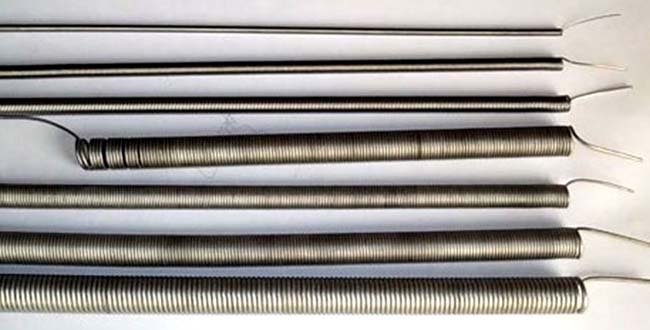
We place the finished spiral on the insulator inside the guide pipe-air duct, leaving a gap to the walls of 5-7 mm.
Important! It is unacceptable to touch the coils of the housing spiral, or to close them together. Winding is done with a slight pretension: when heated, the spiral increases slightly in length and may sag.
A fan is installed at the rear
You can use a ready-made element from a household hair dryer, or a 220-volt fan for a personal computer.
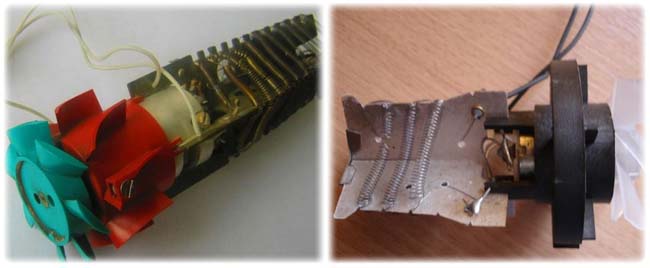
If the fan assembly can be made with a speed controller, this will add functionality to your device. When installing a motor or fan housing, care must be taken to ensure its thermal protection.
note
The body of the hair dryer can become very hot and the plastic will melt. Make gaskets from fluoroplastic or balsa wood. General principle installations - as far as possible from the heating elements, as far as the length of the pipe and common sense allow.
Next we make the handle
If you used a household hair dryer as a donor, this issue has already been resolved. The main thing in this design is to properly secure the air duct with the heater.
The attachment points to the finished body with the handle should be located in the rear.
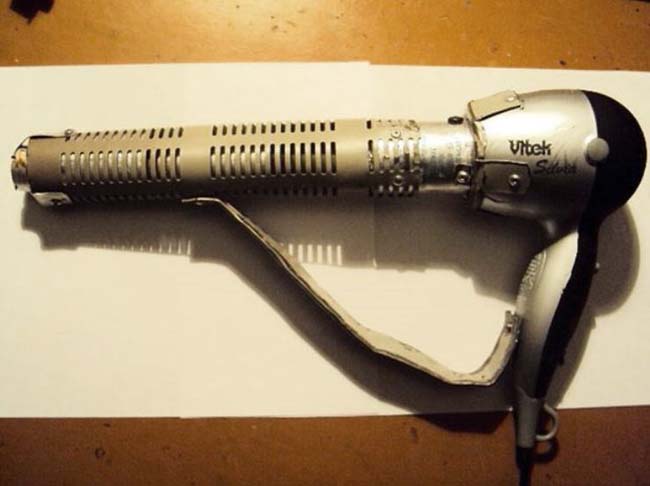
If the hairdryer is made entirely of scrap materials, then the handle is made of any heat-insulating material. For example, made of wood. Again, remember about heating the air duct.
The handle mount is located in a place where there are no heating elements. The best option is a pistol-type power tool.
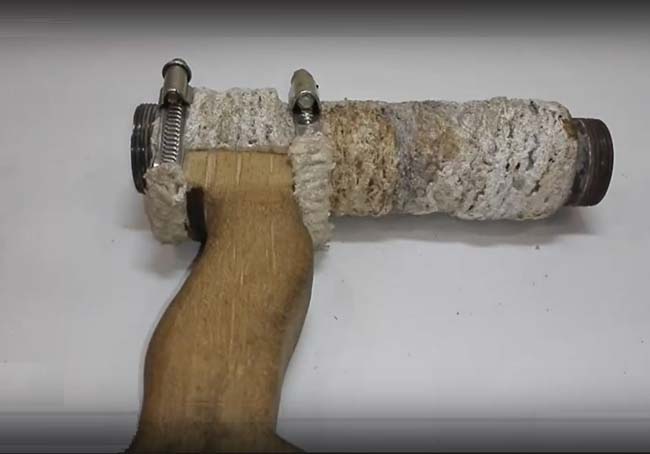
After installing the handle, you can cover the air duct with heat-insulating material. Asbestos or fiberglass pad. This will protect the operator from accidental burns, and will retain heat inside the housing, increasing efficiency.
Electrical wiring and switch
With a spiral resistance of 80 Ohms, according to Ohm's law, the current does not exceed 2.75 A (mains voltage 220 V). The power of the device is about 600 W at maximum temperature.
Accordingly, the switch must withstand at least twice the current in order to maintain the contact group. If there are two operating modes (two spirals), a three-position switch is installed, the middle position is “off”, and two modes of connecting the spiral.
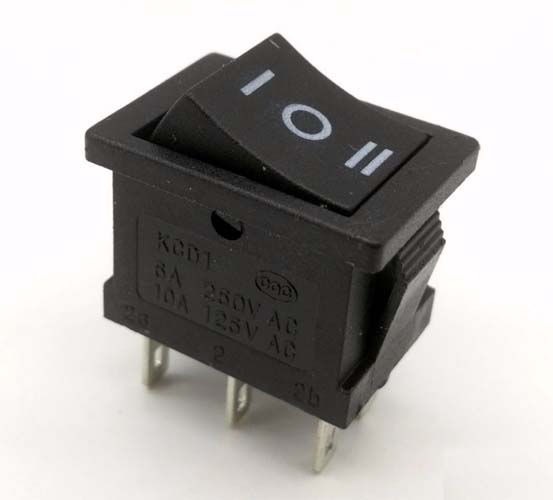
220 V power is connected to the middle pair of contacts, and our spirals are connected to the outer pairs. Industrial designs use a series connection scheme for a motor and spirals.
In this case, it is necessary to accurately calculate the resistance of the electric motor windings for several operating modes. Or a switch with several contact groups is installed (separately for the spirals, separately for the motor).
The homemade design can be simplified. A general switch with two positions supplies power to the motor and mode switch.
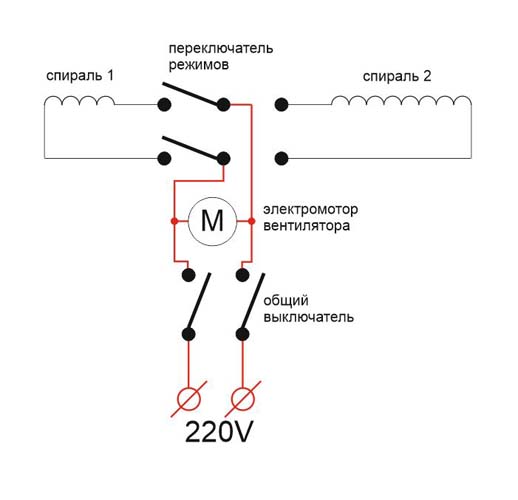
The electric motor works in any case (without spirals it can be used as a directional fan). Then use the mode switch to select the desired spiral.
The simplest design is ready and fully functional. In the video you can see a construction hair dryer in action.
DIY construction hairdryer from a regular hairdryer - video instructions
Result:
If you assemble a hairdryer following electrical safety measures, it will work no worse than its factory counterparts. And the money saved can be spent on more necessary tools.
Such a tool as a hair dryer is little known to ordinary people. But those who use it for its intended purpose claim that it is very convenient and practical, in particular when performing home repairs. The cost of branded models is quite high. They provide various modes that can greatly simplify the workflow. However, as practice shows, many of the “bells and whistles” are absolutely unnecessary, and in order to perform basic heating of materials, you can make a construction hair dryer with your own hands, while significantly saving on the purchase.
The construction dryer is professional tool, which produces a stream of hot air. The temperature of such an air stream sometimes reaches 650°C. Most important characteristic construction hair dryers is the range of powers that a thermal blower can produce. The more power it has, the wider the tool can be used for various types works
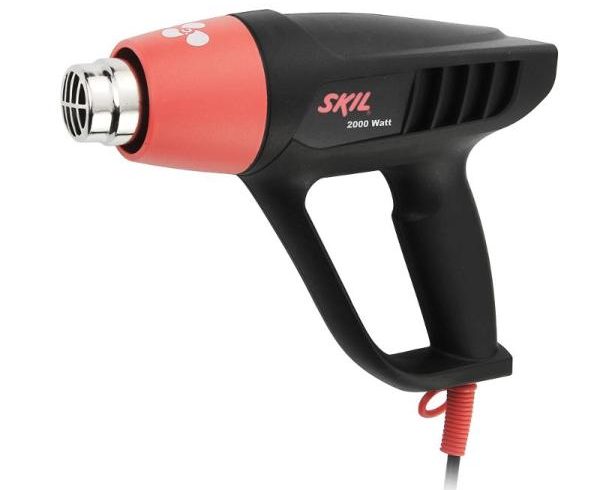
The functionality of construction hair dryers is quite diverse and allows you to perform specific operations without much effort:
- remove old paint and varnishes of any texture;
- remove glue, and therefore thoroughly adhered coatings: wallpaper, linoleum, plywood, etc.;
- wax coating of furniture products;
- defrost all kinds of pipes, including plastic ones;
- weld plastic and film;
- bend plastic pipes;
- conduct quick drying any painted surface or leakage;
- light the coals for the barbecue.
It is worth noting that this is absolutely not all the work that can be performed using this equipment. Depending on the needs of the owner, a hair dryer can be used for many repair tasks.
Equipment diagram and structure
In terms of its design, a technical hair dryer is significantly similar to household models that are used for drying hair. Among the main components in this unit, it is worth noting the mandatory presence of a housing, a heating element and a device that redirects hot air masses to the required location.
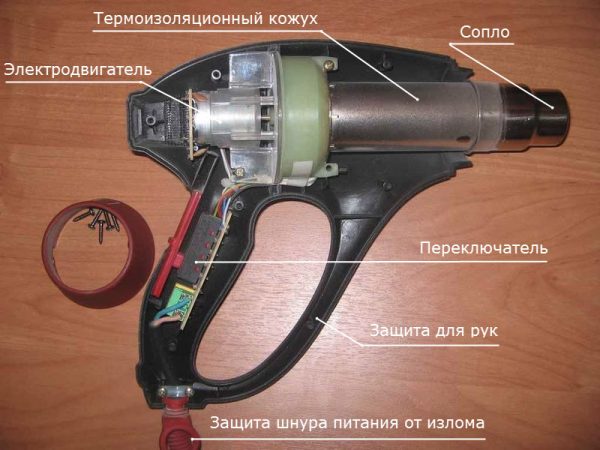
Compared to other thermal devices, a hair dryer does not have an open flame. This feature allows you to reduce the level of fire hazard of the unit and eliminate the need for burning flammable materials.
The device can be distinguished by the presence of the following structural parts:
- Electric motor.
- Heating element.
- Fan.
A hot stream of air is supplied through a metal nozzle narrowed at the end; as a result of such a narrow focus, a powerful stream is formed. For full-fledged work, a construction hair dryer should be equipped with various attachments, which can be easily made independently from available materials. Thanks to them, it will be possible to change the shape of air flows based on the types of work the device is used for.
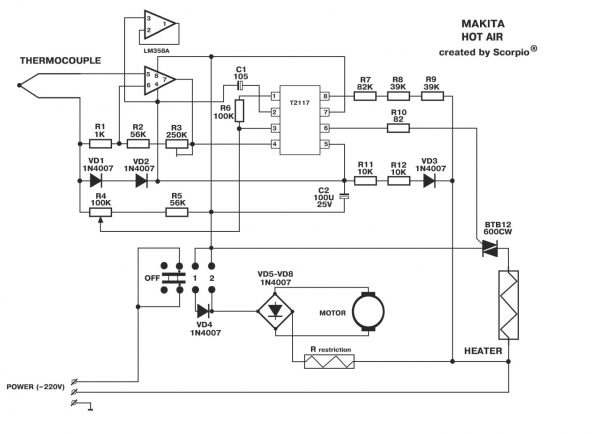
Video “Temperature of a hair dryer”
What you need to make a hair dryer yourself
To assemble a hair dryer yourself, you need to prepare in advance the appropriate components that will be used during the assembly process. To do this you will need to provide:
- An old casing from a regular hair dryer. However, it should not be plastic; only a ceramic design will do.
- Metal blades that will be installed on the fan. They can be cut from a tin sheet.
- Nichrome spiral.
- Power cables. The cross-section of the wire should be more than 4 mm, since the load on the device is expected to be large.
- Pieces of rubber pipes. Their use on a hair dryer allows you to protect your hands well from burns.
- A standard metal nozzle that is flattened at one end. This simple form is used for most applications, allowing for easier melting and reheating.
- A straight round tube that will be used for soldering and welding work.
- Means providing personal protection. In this case, gloves are sufficient.
Self-assembly of the structure: step-by-step process
To produce a full-fledged construction power tool from a household model of a hair dryer, the device must be appropriately modernized by changing its design.
First of all, the hair dryer body is disassembled, and all plastic parts. During operation, they can not only melt and emit a pungent odor, but can also lead to short-circuiting of wires as a result of melting and liquid plastic entering the structure of electrical elements. It is advisable to replace them with textolite or ebonite parts. 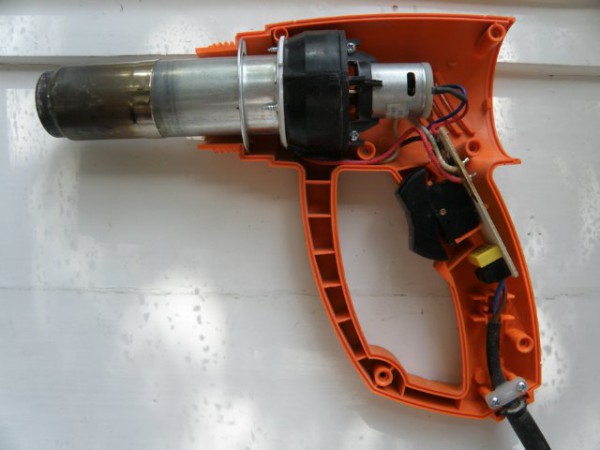
After this, the no longer suitable heating element is replaced with a ceramic part. A nichrome spiral must be wound onto the installed ceramic element. In this case, the turns should be arranged as tightly as possible, since their number determines the heating temperature of the tool - a denser arrangement provides greater heating. During the process, it is important to consider some aspects:
- The ends of the wire must be brought out.
- There should be no contact of the nichrome turns with each other, as this may cause a short circuit.
- Excessively dense laying of turns on a home-made household appliance is also unacceptable, since electrical equipment in a residential area is not intended for serious industrial loads.
To make a heating element, you can use the housing of powerful halogen lamps and nichrome spirals. Lamp glasses have good resistance to high temperatures. The twisted wire should be placed in the glass housing structure. Since solder is not possible for nichrome, the connection is made by securely screwing the ends of the nichrome wire to the transformer wiring. After which everything is carefully isolated.
You should also wrap the finished heating element with foil. In this way, reflected radiation is created, which increases the power of the power tool and minimizes its heat loss. An alternative to using a lamp body is fiberglass, which can be wound on a nichrome spiral, and a durable steel tube placed on top to vent hot air out.
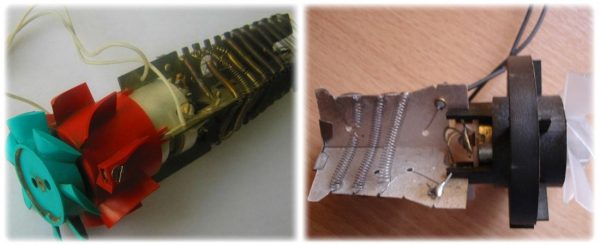
After this, a rubber tube is placed on the handle of the product, which will protect the hand from overheating of the ceramic. The optimal solution may be to use fabric corrugation. For example, it can be taken from vacuum cleaners. It has a rubberized structure, which prevents it from heating up from the outside.
Then the wire should be connected to the transformer, initially installing practically ready product to fan mode. It is important to follow the rule: first of all, the air supply is turned on, and then the heat; when turned off, the actions are performed in the reverse order. It is noteworthy that in order to provide additional air supply, it is recommended to use an aquarium compressor with sufficient power.
The disadvantage of such a device is limited movement, since the wiring and transformer are quite difficult to drag, therefore it is recommended to make holders on stands. When working with homemade devices, you must always remember the safety rules.
The scope of application of this equipment is determined by the shape of the nozzle used, which is necessary for a particular type of work. The nozzle is also called a nozzle, nozzle or nozzle. Each product has its own purpose, according to which it is selected.
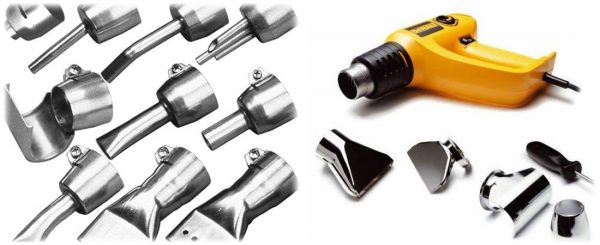
- The flat nozzle allows you to remove old paint, wallpaper, and deform plastic.
- The round nozzle is used for processing copper pipes.
- A reflector nozzle with a rounded bend is used when bending polymer pipes.
- Using crevice nozzles you can weld PVC sheets.
- The side nozzle with built-in glass protection allows you to clean window frames without overheating and breaking the glass.
- The cutting appearance of the nozzle has the appearance of a flattened pipe. Thanks to it, foam plastic is cut.
- The mirror nozzle is used for welding plastic.
Safety when using a hair dryer
To protect yourself from injury, you need to know.
- Sharing use of the device and gas equipment is unacceptable. In particular in kitchen areas where there is a presence open air and flexible hoses. Improper operation and sparking may cause a gas explosion.
- It is prohibited to use a construction hair dryer to work with paint and varnish materials in an unventilated area. When heated, expansion occurs harmful components which are hazardous to health.
- When removing paint, you must first find out what its origin is, as there is a possibility that it contains toxic lead.
- When using a construction hair dryer for any task, it is necessary to provide for the availability of fire extinguishing means in advance.
- The work process must be carried out wearing gloves and clothing with long sleeves to protect yourself from possible burns.
- When removing paint from windows, you should use a special nozzle that protects the glass. But a homemade device naturally does not provide for it. Therefore, it is better to purchase it or remove the paint without using a hair dryer. Since during operation there is a high probability of glass breaking and fragments scattering.
- When working with such equipment, you must ensure that there are no children or animals nearby.
First, the hair dryer is checked from a safe distance. If the device functions properly: the coil heats up to a red state, air is being pumped, then this indicates that the device can be used. To try it out in practice, use something of lesser value.
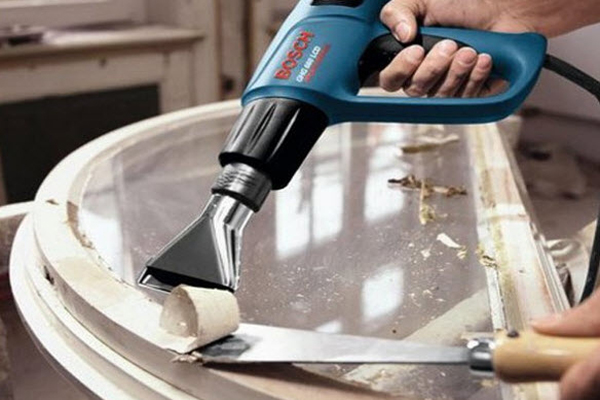
Making a hair dryer with your own hands at home is not easy, since it requires certain skills and knowledge of designing electrical appliances. If you do not take into account the list of necessary requirements, then equipment breakdown is not completely ruled out. To prevent this from happening, you can watch the video tutorials below on how to create devices of this type.
Video “Making a hair dryer”
Video “Working with a construction hairdryer”
Why do you need a construction hair dryer? The answer will be found only after you see its capabilities with your own eyes. And the hair dryer has plenty of these possibilities. Frankly, at our first acquaintance with this unit, we could not take our eyes off - with his own hands the master worked miracles for seconds.
What it is
Girls have their own hairdryer, and men are content with their model. The principle of operation is the same in both devices: a fan drives air through the body of the hair dryer, and there is a hot coil inside. At the outlet, the air comes out already warmed up: depending on the settings, it will be either warm or very hot. The unit itself is usually made in the form of a pistol. A convenient handle, on which the power button and air supply and temperature controls are usually located.
The outlet temperature fluctuates over a fairly wide range. Typically the minimum is around 50-60 degrees and the maximum is 500-600. The air supply speed is also usually regulated so that the spiral does not deteriorate due to overheating. This value can be several hundred liters of air per hour (300-500).
How to choose a hair dryer and what to look for
Choosing a hair dryer is quite simple. Majority construction tools They have much more settings and other nuances, but not a hair dryer.
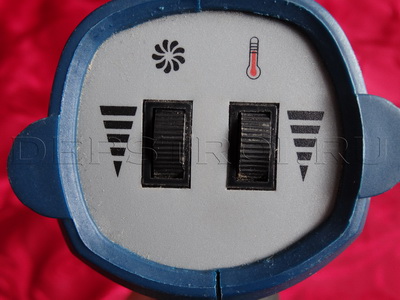
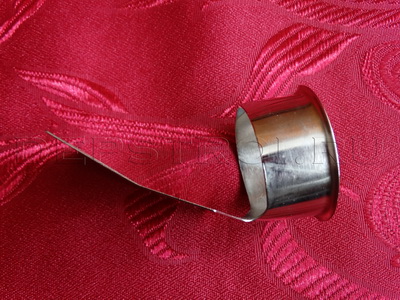
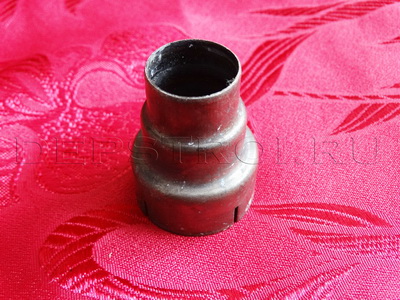
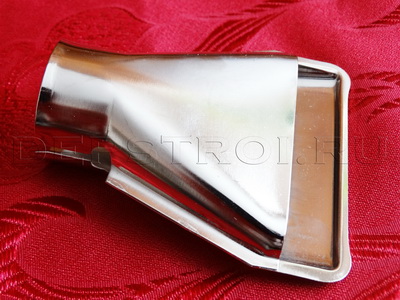
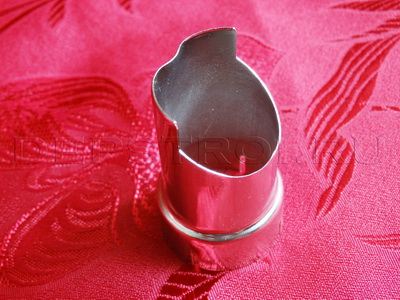
What can you do with a hair dryer?
The construction hair dryer has quite a wide range of applications:
- Removes old paint.
When heated, the paint becomes elastic, peels off from the material and allows itself to be scraped off with the same nozzle or other flat object. Believe me, no other instrument or Chemical substance will not do it well. For example, paint removers will make you protect yourself completely - one drop on your skin or in your eyes and you will know what pain is. And if there are several layers of paint, then the liquid is not able to remove them all. It will take multiple applications, which takes time. A hairdryer allows you to remove paint in seconds, and this is without exaggeration.
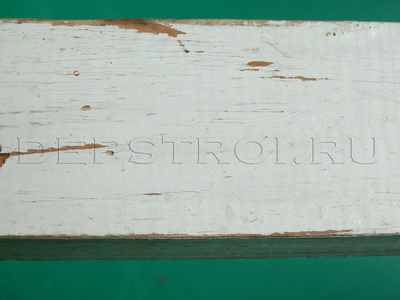
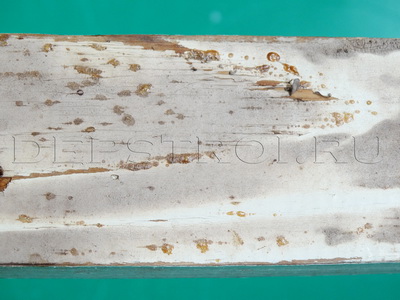
Literally 20-30 seconds of warming up at maximum temperature - and this is the result.
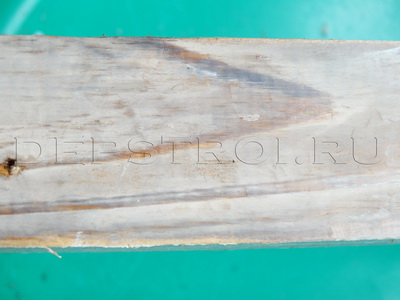
Another 10 seconds and the paint is completely removed.
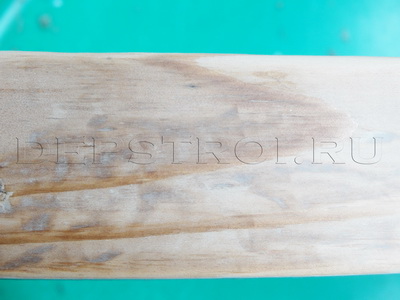
- Defrosting pipes. Plastic pipes with water or other liquid frozen inside can be defrosted. The main thing is that the temperature is not too high and the pipe itself does not melt. This is regulated either by the regulator itself, or by the distance from the hair dryer nozzle to the pipe.
- Deformation of PVC pipes. Do you need to bend a pipe? Having a hairdryer, you will do it quickly and, importantly, without spoiling appearance details. Again, you need to be able to choose the temperature for this, but this will become clear to you in the process. As a last resort, you can always practice on a piece of unnecessary pipe made of the same material.
- Drying. The concept is quite broad: dry parts after gluing or a damp place - hot air will cope with this better than other devices and methods. You just need to know how to dry it. For example, some types of glue are “afraid” high temperatures. When heated above a certain number of degrees, instead of a powerful and reliable connection, you will get the same workpieces that are never fastened together.
- Applying wax, soldering plastic sheets and even some manage to light the barbecue. A perversion, of course, but they thought of it!!!
DIY construction hairdryer
To be honest, we were surprised when we learned that many people were interested in this issue. How to make a hair dryer with your own hands and is it necessary at all? Let's start with the fact that its cost is not that high. The parts you need for assembly will cost you a little less in total, but the hassle will be more than enough. As a result, you will enjoy the work done and handicraft a hair dryer that is unlikely to be as convenient, safe and functional as its factory counterpart. So we can recommend making a hairdryer yourself only to those who like to look for something to do in the workshop. And if time is valuable to you, then it’s better to buy a beautiful suitcase with the treasured device, fully equipped.
Safety precautions
When working with a hairdryer, you should always remember:
- Sawdust, wood dust and other small and flammable objects this kind of must be absent from the work area. If such particles fall even 20-30 centimeters into the area of the directed flow of hot air, they instantly burn out.
- No flammable objects: gasoline, even in a canister, gas cylinder, etc. - all this should not be nearby.
- After work, the tool must be placed so that the nozzle or attachment does not touch objects that are afraid of heated metal. For example, wood, linoleum, plastic. The temperature of the nozzle will remain high for a long time so as to spoil the object, and then the mood.
- When heating painted surfaces with a hairdryer, there will be bad smell. Respiratory protection or ventilation will prevent you from inhaling these harmful contaminants.
- If you need to remove paint from the window and around the glass, the risk is too great. Glass can crack due to temperature differences, and small fragments can fly into your eyes.
- And of course, do not forget that this is an electric tool. Protect the wire from hot air to avoid exposing it. Do not disassemble a plugged-in hair dryer.
Instead of a conclusion
There are jobs where only a hairdryer will help. In any case, this is what the reviews of grateful masters say and we repeat after them. For example, defrost the pipe or bend it in the desired direction. Of course, you are unlikely to perform such operations every day and you do not need to buy this device at all. But if you need a hair dryer even 3-5 or more times a year, then don’t even doubt the advisability of the purchase. In conclusion, we wish you to observe safety precautions, since this subject is quite insidious.
